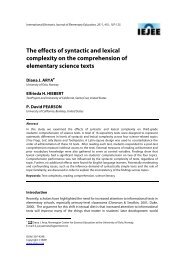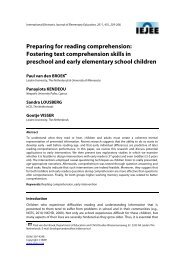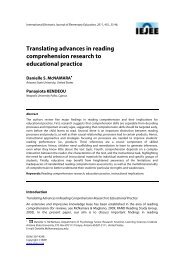Individual differences in children's knowledge of expository text ...
Individual differences in children's knowledge of expository text ...
Individual differences in children's knowledge of expository text ...
You also want an ePaper? Increase the reach of your titles
YUMPU automatically turns print PDFs into web optimized ePapers that Google loves.
<strong>Individual</strong> <strong>differences</strong> <strong>in</strong> children’s <strong>knowledge</strong> / Ray & Meyersentences fit with the stimulus sentences provided. The researchers found that children hadbetter judgments with the collection structure than the comparison, with performancelowest for comparison and description structures. This difference was present on targets(sentences that fit the structure) but not distractors (sentences that did not fit the structure)(Englert & Hiebert, 1984). Similarly, <strong>in</strong> their study <strong>of</strong> 4th -, 6th-, and 8th-graders’ recalls, Smithand Hahn (1989) found that comparison was used less frequently to organize recall thanenumeration and description. In both <strong>of</strong> these cases, levels <strong>of</strong> structural awareness wererelated to the age <strong>of</strong> the readers; older readers demonstrated greater <strong>knowledge</strong> <strong>of</strong> thecomparison structure, than younger readers. This relationship will be further discussed <strong>in</strong> alater section.Other researchers have shown patterns <strong>of</strong> children’s awareness that are somewhat similarto the patterns found with adults. Richgels, McGee, Lomax, & Sheard (1987) found that 6thgradereaders were more sensitive to the comparison structure than the other structuresexam<strong>in</strong>ed (collection, causation, problem-and-solution). They found that causation <strong>text</strong>sposed the greatest challenge to 6th-grade readers; performances on a match<strong>in</strong>g task as wellas organizational rat<strong>in</strong>gs <strong>of</strong> recalls and compositions were lowest for causation (Richgels etal., 1987). Similarly, Yochum (1991) found that 5th graders recalled more ideas when read<strong>in</strong>gcomparison <strong>text</strong>s than when read<strong>in</strong>g attribution (collection) <strong>text</strong>s. However, this effect for<strong>text</strong> structure was not found on a comprehension test. These f<strong>in</strong>d<strong>in</strong>gs suggest that likeadults, children may benefit from more organized <strong>text</strong> structures. However, unlike adults,children’s <strong>knowledge</strong> <strong>of</strong> <strong>text</strong> structure may still be develop<strong>in</strong>g, and those structures that aremost structured like the causation structure, may pose a challenge.In addition to the overall rhetorical structure, <strong>text</strong>ual signal<strong>in</strong>g devices that explicitly<strong>in</strong>dicate the structure <strong>of</strong> the <strong>text</strong> may also <strong>in</strong>fluence readers’ abilities to recognize and usethe <strong>text</strong> structure. Numerous studies which have exam<strong>in</strong>ed the <strong>in</strong>fluence <strong>of</strong> <strong>text</strong> signal<strong>in</strong>g onadult comprehension have demonstrated that signal<strong>in</strong>g is associated with a greater number<strong>of</strong> ideas recalled and more organized recalls (Kardash & Noel, 2000; Lorch & Lorch, 1985;Lorch, Lorch, & Inman, 1993; Ritchey, Schuster, & Allen, 2008; for an extensive review <strong>of</strong> <strong>text</strong>signal<strong>in</strong>g see Lorch, 1989). Research on younger readers’ sensitivity to signal<strong>in</strong>g revealssimilar effects. Ohlhausen and Roller (1988) <strong>in</strong> their exam<strong>in</strong>ation <strong>of</strong> younger readers’sensitivity to structural and content schemas found that <strong>text</strong>s which conta<strong>in</strong>ed elementshighlight<strong>in</strong>g both the structural and content organization were associated with a greaternumber <strong>of</strong> correct ma<strong>in</strong> ideas identified <strong>in</strong> comparison to those <strong>text</strong>s which emphasizedeither the structure or the content. Moreover readers exposed to a <strong>text</strong> which emphasizedthe <strong>text</strong> structure were better able to identify the structural organization (Ohlhausen &Roller, 1988). Similarly, Rossi (1990) found that structural schemas which highlightedmacrosentences and/or the overall rhetorical structure were associated with higherperformance on a test <strong>of</strong> comprehension and a larger number <strong>of</strong> <strong>text</strong> propositions produced<strong>in</strong> 5 th -grade readers’ summaries. The effectiveness <strong>of</strong> signals has been found to vary <strong>in</strong>relation to the overall comprehension skill <strong>of</strong> the reader (Meyer et al., 1980). Nevertheless,previous research suggests that provid<strong>in</strong>g <strong>in</strong>dices <strong>of</strong> the top-level structure <strong>of</strong> <strong>text</strong>s canfacilitate readers’ structural awareness by mak<strong>in</strong>g the structure more explicit.The Relationship between Reader and Text CharacteristicsIn this section, we will exam<strong>in</strong>e previous research which has <strong>in</strong>vestigated sources <strong>of</strong><strong>in</strong>dividual <strong>differences</strong> (read<strong>in</strong>g ability, age, prior <strong>knowledge</strong>) <strong>in</strong> structural awareness andtheir relationship to <strong>text</strong> characteristics. Although we will address these sources <strong>in</strong>dividually,many studies consider multiple reader and <strong>text</strong> <strong>in</strong>fluences simultaneously. Table 1 conta<strong>in</strong>s a71





